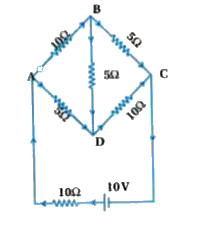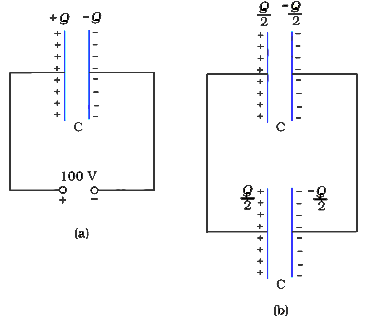Figure 2.32 shows a charge array known as an electric quadrupole. For a point on the axis of the quadrupole, obtain the dependence of potential on r for r/a>>1 , and contrast your results with that due to an electric dipole, and an electric monopole (i.e., a single charge).
 Solution in Gujrati
Solution in Gujrati
Potential at point P
V=k[qr−a−qr−qr+qr+a]
=kq[1r−a−2r+1r+a]
=kq[r(r+a)−2(r2−a2)+r(r−a)r(r2−a2)]
=kq[r2+ra−2r2+2a2+r2−rar(r2−a2)]
=kq[2a2r(r2−a2)]
=kQr(r2−a2)
where Q=Quadrupole moment
If r>> a and a2 is neglected with compare to r2
V=kQr3
∴V∝1r3 for quadrupole
V∝1r2 for dipole
and V∝1r for monopole
Topper's Solved these Questions
- ELECTROSTATIC POTENTIAL AND CAPACITANCEBOOK - KUMAR PRAKASHANCHAPTER - ELECTROSTATIC POTENTIAL AND CAPACITANCEEXERCISE - Section B ( Numerical From DARPAN. Based on Textbook )
19 Videos
- ELECTROSTATIC POTENTIAL AND CAPACITANCEBOOK - KUMAR PRAKASHANCHAPTER - ELECTROSTATIC POTENTIAL AND CAPACITANCEEXERCISE - Section B (questions)
2 Videos
- ELECTROSTATIC POTENTIAL AND CAPACITANCEBOOK - KUMAR PRAKASHANCHAPTER - ELECTROSTATIC POTENTIAL AND CAPACITANCEEXERCISE - Section B Numericals
16 Videos
- ELECTROMAGNETIC WAVESBOOK - KUMAR PRAKASHANCHAPTER - ELECTROMAGNETIC WAVESEXERCISE - BOARD.S QUESTION PAPER MARCH - 2020 (PART - B) SECTION - C
5 Videos
- MAGNETISM AND MATTERBOOK - KUMAR PRAKASHANCHAPTER - MAGNETISM AND MATTEREXERCISE - SECTION D Multiple Choice Questions (MCQs) (MCQs asked in Competitive Exams) MCQs asked in Board Exam and GUJCET
7 Videos
Similar Questions
An electric field is represented by →E=Axˆi where A = 10Vm2 . Find the potential of the origin with respect to the point (10,20) m.
View SolutionA slab of material of dielectric constant K has the same area as the plates of a parallel plate capacitor but has a thickless (12)d. Where d is the separation of the plates . How is the capacitance changed when the slab is inserted between the plates
View SolutionCalculate the potential at a point P due to a charge of 4×10−7 C located 9 cm away.
View SolutionDetermine the current in each branch of the given network.

View SolutionAt a place on earth the vertical component of earth's magnetic field is √3 times its horizontal component. The angle of dip at this place is …...
View SolutionFig shows a charge array known as an 'electric quadrupole'. For a point on the axis of the quadrupole, obtain the dependence of potential on r for r/a>>1, and contract your results with that due to an electric dipole and an electric monopole (i.e, a single charge).

View SolutionFigure shows a charge array known as an "electric quadrupole". For a point on the axis of the quadruple, the dependence of potential on r(r/agt gt1) is 1/(r^(n)) . Find n ?
View Solutionनीचे दिए गए चित्र 2.32 में के आवेश विन्यास जिसे विद्युत चतुर्ध्रुवी कहा जाता है, दर्शाया गया है । चतुर्ध्रुवी के अक्ष पर स्थित किसी बिंदु के लिए r पर विभव कि निर्भरता प्राप्त कीजिए जहाँ r/a>>1 । अपने परिणाम कि तुलना एक विद्युत द्विध्रुत व विद्युत एकल ध्रुव (अर्थात किसी एकल आवेश) के लिए प्राप्त परिणामों से कीजिए ।

View Solutionनिम्न चित्र में एक आवेश विन्यास जिसे विद्युत चतुर्ध्रुवी कहा जाता है, दर्शाया गया है। चतुर्ध्रुवी के अक्ष पर स्थित किसी बिंदु के लिए r पर विभव की निर्भरता प्राप्त कीजिए जहाँ r/a>>1 अपने परिणाम की तुलना एक विद्युत द्विध्रुव व विद्युत एकल ध्रुव (अर्थात किसी एकल आवेश) के लिए प्राप्त परिणामो से कीजिए।

View Solutionचित्र में प्रदर्शित चार आवेशों का संयुक्त निकाय विधुत-चतुध्रुव (electric quadrupole) कहा जाता है । निकाय के अक्ष पर केंद्र से r दूरी पर स्थित बिंदु P पर विभव का व्यंजक प्राप्त करें , यदि ar<<1. प्राप्त परिणाम की तुलना एक विधुत-द्विध्रुव (electric dipole) एवं विधुत एकल ध्रुव (electric monopole) के कारण विभव से करें ।

View SolutionElectric potential (ϕ) of a quadrupole varies with distance 'r' on its axis as :-
View SolutionThe figure given below shows a charge array known as an 'electric quadrupole'. For a point on the axis of the quadrupole, obtain the dependence of potential on r for (r )/(a) gt gt 1 . Contrast your result with that due to an electric dipole and an electric monopole (i.e. a single charge).
View SolutionDeduce an expression for the electric potential due to an electric dipole at any point on its axis. Mention one contrasting feature of electric potential of a dipole at a point as compared to that due to a single charge.
View SolutionFigure shows a charge array known as an electric quadrupole. For a point on the axis of the quadrupole, obtain the dependence of potential on 'r' for r/a gt gt 1 , and contrast your result with that due to an electric dipole, and an electric monopole (i.e, a single charge)
View SolutionFigure 2.32 shows a charge array known as an electric quadrupole. For a point on the axis of the quadrupole, obtain the dependence of potential on r for r/a>>1 , and contrast your results with that due to an electric dipole, and an electric monopole (i.e., a single charge).

View SolutionFigure 2.32 shows a charge array known as an electric quadrupole. For a point on the axis of the quadrupole, obtain the dependence of potential on r for r//a gt gt 1 , and contrast your results with that due to an electric dipole, and an electric monopole (i.e., a single charge).
View Solution
